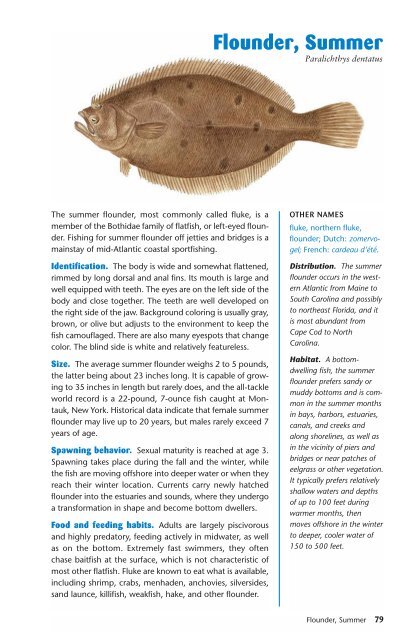Ken Schultz's Field Guide to Saltwater Fish - Macaw Pets store
Ken Schultz's Field Guide to Saltwater Fish - Macaw Pets store
Ken Schultz's Field Guide to Saltwater Fish - Macaw Pets store
Create successful ePaper yourself
Turn your PDF publications into a flip-book with our unique Google optimized e-Paper software.
The summer flounder, most commonly called fluke, is a<br />
member of the Bothidae family of flatfish, or left-eyed flounder.<br />
<strong>Fish</strong>ing for summer flounder off jetties and bridges is a<br />
mainstay of mid-Atlantic coastal sportfishing.<br />
Identification. The body is wide and somewhat flattened,<br />
rimmed by long dorsal and anal fins. Its mouth is large and<br />
well equipped with teeth. The eyes are on the left side of the<br />
body and close <strong>to</strong>gether. The teeth are well developed on<br />
the right side of the jaw. Background coloring is usually gray,<br />
brown, or olive but adjusts <strong>to</strong> the environment <strong>to</strong> keep the<br />
fish camouflaged. There are also many eyespots that change<br />
color. The blind side is white and relatively featureless.<br />
Size. The average summer flounder weighs 2 <strong>to</strong> 5 pounds,<br />
the latter being about 23 inches long. It is capable of growing<br />
<strong>to</strong> 35 inches in length but rarely does, and the all-tackle<br />
world record is a 22-pound, 7-ounce fish caught at Montauk,<br />
New York. His<strong>to</strong>rical data indicate that female summer<br />
flounder may live up <strong>to</strong> 20 years, but males rarely exceed 7<br />
years of age.<br />
Spawning behavior. Sexual maturity is reached at age 3.<br />
Spawning takes place during the fall and the winter, while<br />
the fish are moving offshore in<strong>to</strong> deeper water or when they<br />
reach their winter location. Currents carry newly hatched<br />
flounder in<strong>to</strong> the estuaries and sounds, where they undergo<br />
a transformation in shape and become bot<strong>to</strong>m dwellers.<br />
Food and feeding habits. Adults are largely piscivorous<br />
and highly preda<strong>to</strong>ry, feeding actively in midwater, as well<br />
as on the bot<strong>to</strong>m. Extremely fast swimmers, they often<br />
chase baitfish at the surface, which is not characteristic of<br />
most other flatfish. Fluke are known <strong>to</strong> eat what is available,<br />
including shrimp, crabs, menhaden, anchovies, silversides,<br />
sand launce, killifish, weakfish, hake, and other flounder.<br />
Flounder, Summer<br />
Paralichthys dentatus<br />
OTHER NAMES<br />
fluke, northern fluke,<br />
flounder; Dutch: zomervogel;<br />
French: cardeau d’été.<br />
Distribution. The summer<br />
flounder occurs in the western<br />
Atlantic from Maine <strong>to</strong><br />
South Carolina and possibly<br />
<strong>to</strong> northeast Florida, and it<br />
is most abundant from<br />
Cape Cod <strong>to</strong> North<br />
Carolina.<br />
Habitat. A bot<strong>to</strong>mdwelling<br />
fish, the summer<br />
flounder prefers sandy or<br />
muddy bot<strong>to</strong>ms and is common<br />
in the summer months<br />
in bays, harbors, estuaries,<br />
canals, and creeks and<br />
along shorelines, as well as<br />
in the vicinity of piers and<br />
bridges or near patches of<br />
eelgrass or other vegetation.<br />
It typically prefers relatively<br />
shallow waters and depths<br />
of up <strong>to</strong> 100 feet during<br />
warmer months, then<br />
moves offshore in the winter<br />
<strong>to</strong> deeper, cooler water of<br />
150 <strong>to</strong> 500 feet.<br />
Flounder, Summer 79


